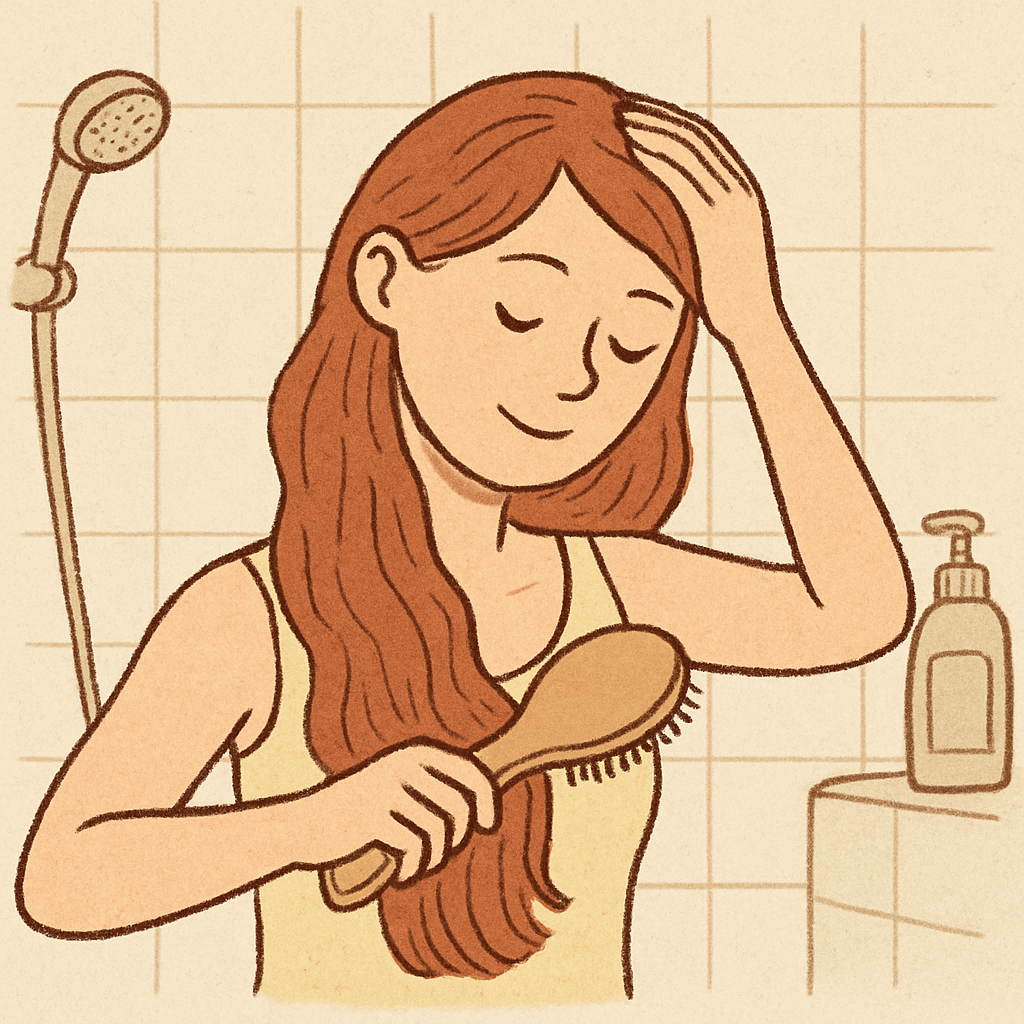
How to Wash Hair: Tips for a Perfect Hair Care Routine
Essential Steps for Washing Your Hair
Washing your hair might seem simple, but doing it right can make a big difference. Proper hair washing is key to maintaining healthy, shiny locks.
Many people overlook the importance of using the right techniques and products. This can lead to common issues like dryness, frizz, or even hair damage.
Understanding your hair type and its specific needs is crucial. Whether you have wavy, curly, or straight hair, each requires a unique approach.
In this guide, we'll explore essential steps for washing your hair properly. You'll learn tips and tricks for different hair types and situations.
Get ready to transform your hair care routine and achieve the best hair wash every time.
Why Proper Hair Washing Matters
Proper hair washing is the foundation of a good hair care routine. It ensures that your scalp stays clean and free from excess oils and products.
Ignoring the right techniques can lead to buildup, dullness, or hair damage over time. It's not just about cleanliness; it's about nourishment and health.
Here’s why it matters:
- Promotes hair growth
- Enhances shine and texture
- Minimizes scalp issues
Preparing Your Hair for Washing
Before getting your hair wet, take a few steps to prepare. Start by brushing your hair to remove any tangles or knots. This helps reduce breakage while washing.
Next, gather the necessary products and tools. Ensure you have your shampoo, conditioner, and a wide-tooth comb ready. Having everything on hand makes the process smoother.
Wet your hair thoroughly using lukewarm water. Lukewarm water opens the cuticles for better cleansing and absorption of products. Avoid hot water as it can damage and dry out the hair.
Here’s a quick prep list:
- Brush thoroughly
- Gather products and tools
- Use lukewarm water
Step-by-Step Guide: How to Wash Hair Properly
Begin by thoroughly soaking your hair with lukewarm water. This helps to loosen any dirt or product buildup. Make sure every strand is wet before applying shampoo.
Pour a small amount of shampoo into your palm. For most hair types, a nickel-sized amount should suffice. Adjust the amount based on hair length and thickness.
Focus the shampoo on your scalp, as this is where oil and dirt accumulate. Gently massage your scalp using your fingertips, not your nails. This stimulates blood circulation and cleans effectively.
After massaging, rinse your hair thoroughly with lukewarm water. Ensure no shampoo residue remains. Residue can cause irritation and dullness.
Next, apply conditioner to the mid-lengths and ends of your hair. Avoid applying it to the roots to prevent a greasy look. Let the conditioner sit for a few minutes.
Use a wide tooth comb to distribute the conditioner evenly. This also helps detangle your hair. Rinse the conditioner thoroughly until the water runs clear.
Here’s a quick washing checklist:
- Wet hair completely
- Apply shampoo to scalp
- Massage gently
- Rinse thoroughly
- Apply conditioner to ends
- Comb through gently
Choosing the Right Shampoo and Conditioner
Picking suitable shampoo and conditioner is key to a successful wash. Hair type and specific concerns should guide your choice. For instance, colored hair needs a color-safe shampoo.
Opt for sulfate-free formulas if you have sensitive skin or colored hair. These are gentler and prevent fading. Moisturizing formulas work well for dry hair.
Some factors to consider:
- Hair type (dry, oily, normal)
- Specific issues (dandruff, damage)
- Ingredients (sulfate-free, moisturizing)
Shampooing Techniques for Different Hair Types
Different hair types require different shampooing methods. Oily hair benefits from frequent washes, focusing on the scalp. Use a gentle shampoo that controls oil.
For wavy or curly hair, less frequent washing is better. Limit shampooing to 2-3 times weekly. This helps maintain natural oils.
Wavy and curly hair tips:
- Wash 2-3 times a week
- Use nourishing shampoos
- Avoid aggressive massaging
Fine hair can get weighed down easily. Use lightweight products and focus on the scalp. This method provides volume without oil buildup.

Conditioning for Healthy, Shiny Hair
Conditioner plays a critical role in your hair care routine. It's essential for moisture and detangling. Use a suitable conditioner based on your hair type and needs.
Apply conditioner from mid length to tips. This focuses hydration where it’s needed most. Avoid scalp application to prevent oiliness.
Useful conditioning tips:
- Choose conditioner based on hair type
- Avoid roots when applying
- Let it sit for a few minutes
Rinse the conditioner with cool water. This helps seal your hair cuticles, adding shine. It’s a simple trick for enhanced hair luster.
Special Hair Washing Tips and Tricks
Elevate your hair washing routine with some simple tricks. These small changes can make a big difference in hair health and appearance. Tailor these to suit your hair type and lifestyle.
Consider using a shower filter if you live in a hard water area. A filter reduces mineral buildup and leaves hair softer. It's especially beneficial for those with color-treated hair.
Additional tips for better hair washing:
- Use a microfiber towel to reduce frizz
- Rinse hair with cold water to seal cuticles
- Add a monthly scalp exfoliation for deeper clean
How Often Should You Wash Your Hair?
Finding the right washing frequency depends on your hair type and lifestyle. Over washing strips natural oils, while under-washing leads to buildup. Balance is key.
For most hair types, washing every 2-3 days works well. Adjust based on your hair’s needs and environmental factors. For instance, frequent workouts may require more regular washing.
Consider the following recommendations:
- Normal hair: every 2-3 days
- Dry hair: once or twice a week
- Oily hair: every other day
How Often to Wash Wavy, Curly, and Oily Hair
Wavy and curly hair tends to be drier. This means less frequent washing helps preserve moisture. Oily hair, however, can require more frequent attention.
Here's a quick guide:
- Wavy hair: every 2-3 days to keep natural oils balanced.
- Curly hair: once a week or co-wash mid-week.
- Oily hair: every other day or as needed.
Washing Hair After Coloring, Toner, or Highlights
After coloring your hair, it's crucial to take special care when washing. The first wash is vital for maintaining vibrant color and health. Gentle products are necessary to preserve the treatment.
Use sulfate-free shampoos designed for colored hair. They help prevent fading and keep your hair looking fresh. Also, avoid hot water, which can lead to color wash-out.
Keep these steps in mind:
- Wait before your first wash.
- Use color-safe, sulfate-free shampoo.
- Rinse with cool water to seal cuticles.
How Long to Wait to Wash Hair After Dye, Toner, or Highlights
Timing matters for keeping color treatments intact. Waiting the right time before the first wash lets the color set.
Here's how long to wait:
- After dye: 48-72 hours
- After toner: At least 48 hours
- After highlights: 72 hours
Allowing enough time helps lock in the color, ensuring longer-lasting, brilliant results. Adjust based on stylist recommendations.
How to Wash Hair Extensions and Clip-Ins
Hair extensions require special care to maintain their look and longevity. Start by gently brushing out any tangles before washing. Use a sulfate-free, gentle shampoo to prevent damage and keep them soft.
Wash extensions separately from your natural hair. Apply shampoo from roots to ends, taking care not to rub. Rinse thoroughly with cool water to avoid tangling.
Remember these tips for washing:
- Detangle before washing.
- Use sulfate-free shampoo.
- Rinse with care.
After washing, gently squeeze out excess water. Lay extensions flat to dry or use a microfiber towel. Avoid wringing to prevent damage.
How to Wash Out Hair Dye Safely
Washing out hair dye requires care to maintain your new color. Avoid hot water as it can cause fading. Use a color-safe shampoo designed for dyed hair.
Focus on gentle techniques to preserve the vibrancy. Rinse thoroughly with cool water to help lock in the color.
Remember these steps:
- Use color-safe shampoo.
- Avoid hot water.
- Rinse with cool water.
Common Hair Washing Mistakes to Avoid
Many overlook simple errors that affect hair health. One frequent mistake is using water that's too hot. Hot water strips essential oils and causes dryness.
Another issue is using too much shampoo. It can lead to buildup and dullness. Always rinse thoroughly and avoid harsh products. Here are some mistakes to watch for:
- Using hot water
- Overusing shampoo
- Rinsing inadequately
Building the Best Hair Care Routine
Crafting a solid hair care routine can transform your locks. Start by choosing products that match your hair type and condition. Regular trims keep hair healthy by preventing split ends.
Incorporate these practices for optimal results:
- Use sulfate-free products
- Limit heat styling
- Deep condition weekly
Frequently Asked Questions About Hair Washing
Many people wonder how often they should wash their hair or what products are best for specific hair types. The answers can vary based on personal needs and hair condition.
Here are some common questions:
- How often should I wash curly hair?
- Is sulfate-free shampoo necessary for color-treated hair?
- Can I wash my hair every day?
Conclusion: Achieve the Best Hair Wash Every Time
Washing your hair the right way can enhance its health and look. By following these steps and tips, you can ensure each wash leaves your hair refreshed and shiny.
Customize your routine according to your hair type and needs. This will help you maintain luscious, beautiful hair with every wash.
Share





